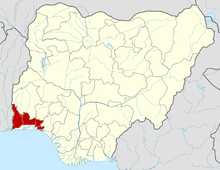Imeko Afon
| Imeko Afon | |
|---|---|
| LGA | |
 Imeko Afon Location in Nigeria | |
| Coordinates: 7°38′N 2°52′E / 7.633°N 2.867°ECoordinates: 7°38′N 2°52′E / 7.633°N 2.867°E | |
| Country |
|
| State | Ogun State |
| Area | |
| • Total | 1,655 km2 (639 sq mi) |
| Population (2006 census) | |
| • Total | 82,217 |
| Time zone | WAT (UTC+1) |
| 3-digit postal code prefix | 111[1] |
| ISO 3166 code | NG.OG.IA |
Imeko Afon is a Local Government Area in the west of Ogun State, Nigeria bordering the Republic of Benin. Its headquarters are in the town of Imeko at coordinates 7°29′00″N 2°53′00″E / 7.48333°N 2.88333°E.
Location
The local Government was created from the old Egbado North Local Government in December 1996, during the military regime of General Sani Abacha. The land area is about 1,711.43 square kilometres (660.79 sq mi).[2] The land is rolling, with small hills rising between 15 and 70 metres above sea level. The Yewa River runs through the area from North to South, with its tributaries, the rivers Oyan and Oha.[3] The LGA is bounded in the north by Oyo State, to the east by the Abeokuta North LGA, to the south by the Yewa North LGA and to the west it shares an international border with Benin.[2] The international border is 93 kilometres (58 mi), and is one of the most accessible stretches of border between the two countries.[3]
The Local Government is divided into ten political wards: Imeko, Afon, Ilara, Iwoye/Jabata, Idofa, Owode/Obada/Idi-Ayin, Moriwi / Matale /Oke-Agbede, Agborogbomo, Atapele and Kajole / Agberiodo.[4] Imeko, the LGA headquarters, is about 20 kilometres (12 mi) by road from Ketou, a major trading town in Benin. The second largest settlement, Ilara, merges into Kanga in Benin.[3]
People
The 1991 population census gave a population of about 118,339. The people are mostly Yorubas of Ketu origin, but there are significant numbers of Ohori and Egun speaking people.[2] As a border community, other West African people live in the LGA, including a substantial number of Fulani nomads.[4]
In March 2011, just before the April National elections, it was reported that a mass transfer of teachers disloyal to the Peoples Party of Nigeria (PPN) had begun in the LGA.[5]
Economy
Farming is the main economic activity.[2] The vegetation is a mixture of savannah belt and sparse forest suitable for cattle raising, with the advantage of being free of Tse-tse flies.[3] The climate is tropical, with a rainy season commencing around March and ending in November. The soil is fertile, and Cassava and Tomatoes are grown in large quantities.[4] Cotton grown in the LGA supplies the Yaru, tread and textile industries in Benin Republic. Other crops are pepper, maize, groundnuts, yams, vegetables, cocoa, cashew and teak.[3]
The LGA has 43 public primary schools and 6 secondary schools, and a number of private schools.[2] Tourist attractions include Celestial City, center of the Celestial Church of Christ, Imeko, Odosuuru waterfalls, Mount Boomu, Afon and Jabata Forest.[4] To encourage tourists the LGA is named the "virgin land", and in 2010 a 20 kilometres (12 mi) Imeko-Oke-Agbede-Iwoye road was being built.[6]
References
- ↑ "Post Offices- with map of LGA". NIPOST. Archived from the original on November 26, 2012. Retrieved 2009-10-20.
- 1 2 3 4 5 "Imeko-Afon". Ogun State Government. Retrieved 2011-06-12.
- 1 2 3 4 5 "HISTORY OF IMEKO/AFON LOCAL GOVERNMENT". Imeko Afon LGA. 20 March 2011. Retrieved 2011-06-12.
- 1 2 3 4 "Imeko-Afon Local Government". Ogun State Ministry of Local Government and Chieftaincy Affairs. Retrieved 2011-06-12.
- ↑ Femi Ogbonnikan (29 March 2011). "Gale of Transfers Hit Teachers in Imeko-Afon". Daily Independent (Lagos).
- ↑ Segun Adeleye (14 July 2010). "As Imeko-Afon LG Inaugurates Elders' Council (1)". The Daily Independent (Lagos). Retrieved 2011-06-12.
